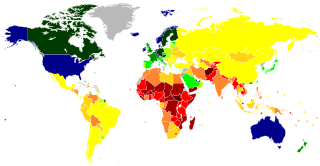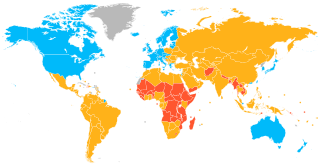
Gross domestic product (GDP) is a monetary measure of the market value of all the final goods and services produced in a specific time period by a country or countries. GDP is most often used by the government of a single country to measure its economic health. Due to its complex and subjective nature, this measure is often revised before being considered a reliable indicator.

Per capita income (PCI) or total income measures the average income earned per person in a given area in a specified year. It is calculated by dividing the area's total income by its total population.

A developed country, or high-income country, is a sovereign state that has a high quality of life, developed economy, and advanced technological infrastructure relative to other less industrialized nations. Most commonly, the criteria for evaluating the degree of economic development are the gross domestic product (GDP), gross national product (GNP), the per capita income, level of industrialization, amount of widespread infrastructure and general standard of living. Which criteria are to be used and which countries can be classified as being developed are subjects of debate. Different definitions of developed countries are provided by the International Monetary Fund and the World Bank; moreover, HDI ranking is used to reflect the composite index of life expectancy, education, and income per capita. Another commonly used measure of a developed country is the threshold of GDP (PPP) per capita of at least US$22,000. In 2023, 40 countries fit all four criteria, while an additional 15 countries fit three out of four.

The Human Development Index (HDI) is a statistical composite index of life expectancy, education, and per capita income indicators, which is used to rank countries into four tiers of human development. A country scores a higher level of HDI when the lifespan is higher, the education level is higher, and the gross national income GNI (PPP) per capita is higher. It was developed by Pakistani economist Mahbub ul-Haq and was further used to measure a country's development by the United Nations Development Programme (UNDP)'s Human Development Report Office.
The Human Poverty Index (HPI) was an indication of the poverty of community in a country, developed by the United Nations to complement the Human Development Index (HDI) and was first reported as part of the Human Development Report in 1997. It is developed by United Nations Development Program which also publishes indexes like HDI It was considered to better reflect the extent of deprivation in deprived countries compared to the HDI. In 2010, it was supplanted by the UN's Multidimensional Poverty Index.
Household income is a measure of the combined incomes of all people sharing a particular household or place of residence. It includes every form of income, e.g., salaries and wages, retirement income, near cash government transfers like food stamps, and investment gains.
The Gender Development Index (GDI) is an index designed to measure gender equality.
This is a list of key international rankings of Costa Rica

After a significant decline in earlier decades, crude birth rates in Armenia slightly increased from 13.0 in the year 1998 to 14.2 in 2015; this timeframe also showed a similar trajectory in the crude death rate, which grew from 8.6 to 9.3. Life expectancy at birth at 74.8 years was the 4th-highest among the Post-Soviet states in 2014.




